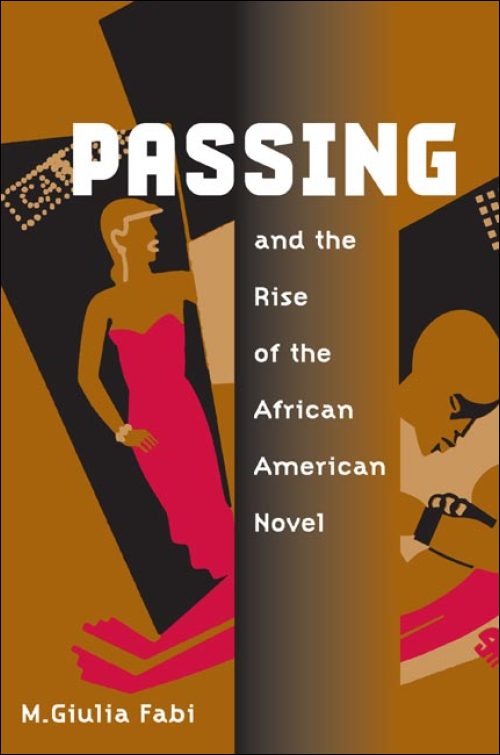Passing: Race, Identification and Desire
Criticism: A Quarterly for Literature and the Arts
Volume 45, Number 4 (Fall 2003)
pages 435-52
Catherine Rottenberg, Assistant Professor
Department of Foreign Literatures and Linguistics and the Gender Studies Program
Ben-Gurion University, Beer-Sheva, Israel
IN THE SECOND HALF of the nineteenth century, African-American writers such as William Wells Brown and Frances Harper began invoking the phenomenon of passing in their texts as a way of investigating the complexities and contradictions of the category of race in the United States. The light-enough-to-pass Negro (but usually Negress) would play a central role in the imagination of African-American writers for the next fifty years. Charles Chesnutt’s The House behind the Cedars, Jessie Faucet’s Plum Bun, and James Weldon Johnson’s The Autobiography of an Ex-Coloured Man are perhaps the best-known examples. Nella Larsen’s 1929 novella, Passing, the text under discussion in this essay, can thus be seen as inheritor and perpetuator of a long tradition of such narratives. In recent years, Larsen’s text has become the most celebrated instance of a story about passing in African-American literature, eclipsing the tradition that preceded it. This is not coincidental, for Larsen is a master of ambiguity and intrigue, and the enigmatic finale of her novella has generated heated debates and countless interpretations.
Many analyses have attempted to determine whether or not Larsen’s use of passing can be seen as a subversive strategy, that is, whether the narrative serves to reinforce hegemonic norms of race or whether it ultimately posits passing as a viable survival strategy, which has the potential to disrupt “the enclosures of a unitary identity.” While this question still informs several critiques, in the past few years commentators have been concentrating more and more on how passing interrogates and problematizes the ontology of identity categories and their construction. Rather than trying to place passing in a subversive recuperative binary, these articles and books use passing as a point of entry into questions of identity and identity categories more generally.
In this essay I contend that Larsen’s text can assist critics in understanding the specific and, as I will argue, irreducible features of race performativity. That is, the novella can help us begin mapping out the differences between gender and race norms since it uncovers the way in which regulatory ideals of race produce a specific modality of performativity. Passing is especially conducive to interrogating the modality of race performativity because, unlike other passing narratives of the period, Larsen’s presents us with two protagonists who can pass for white; yet only Clare “passes over” into the white world. The depiction and juxtaposition of these two characters reveal the complexities and intricacies of the category of race. While Irene can be seen to represent the subject who appropriates and internalizes the hegemonic norms of race, Clare’s trajectory dramatizes how dominant norms can be misappropriated and how disidentification is always possible.
This essay commences with a theoretical discussion of race. Although much has been written on the constructed nature of the category of race, very few analyses have offered a convincing and rigorous account of how race might be conceived of as performative reiteration. The second section offers a reading of “passing” scenes from the novella in an attempt to unravel some of the distinctive mechanisms through which race norms operate. On the one hand, the novella suggests that race in the United States operates through an economy of optics, and the assumption of whiteness is one of the consequences of this economy. On the other hand, the novella reveals that skin color (i.e., optics) does not really constitute the “truth” of race.
Invoking Homi Bhabha’s notion of mimicry as a supplement to Butler’s concept of gender performativity in the third section, I interrogate and theorize the ways in which the definitional contradiction of race (“can be seen” versus “cannot be seen”) produces race as performative reiteration. While there are two idealized genders under regimes of compulsory heterosexuality, albeit with a very great power differential between them, there has historically been only one hegemonic and ideal race under racist regimes. This difference, I argue, has far-reaching implications, one of which is the need to rethink the desire/identification nexus, a nexus that operates differently in race and in gender. Understanding the particular relationship between desire and identification in the novella also helps us begin to gauge the critical question of disidentification.
At least one clarification is needed at this point, however. This essay focuses on the ways in which power—in the Foucauldian and Butlerian sense—operates on the hegemonic level and does not make a claim about the multiplicity of social practices per se. Hegemony, though, as we will see in the last section, is never complete, indicating that there are always counterdiscourses and alternative norms circulating within any given society…
Read the entire article here.

